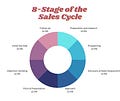This article is from Gemma Serenity Gorokhoff. She is an award-winning entrepreneur educated at MIT, NYU Mindfulness, IMD ranked #1 for the 12th year in a row by Financial Times in executive education, in the fields of leadership, negotiation, and personal development with 25 years of experience helping others find their voice and step into the energy of success. She continues her studies at Kellogg Northwestern University in business and professional sales.
After victoriously overcoming 15 years of domestic violence, she now uses her voice, writing, consulting, and online courses, to share her insights on shifting your mindset, focusing on self-love, self-confidence, self-esteem, as well as money, relationships, time and is an advocate against domestic abuse. Discover more about her at https://www.rtrw.media
Introduction to the sales process
When is the last time you have been consciously selling? Is it a daily occurrence for you or is it only when you don’t see a way out of your financial situation?
In this group, we focus on professional sales, where it’s normal to sell for a living all week long. And the truth is that even though we may be professional salespeople, there is still some resistance going on when we are breaking the ice and going to talk to new people. The fear of rejection is a real thing, even though we learned to tame it and deal with it, to get over it, and to rejoice in going on and selling our products or services.
The different stages of the sales process
Prospecting
Discover who could potentially become a client with inbound and outbound activities. Inbound is when a potential client, also known as “lead”, comes knocking at our business door. Outbound is when we go out in the open, in a networking group in person or in a social media setting, and we ask questions to probe if someone could have an interest in our service or product.
Qualifying
After having identified someone who showed an interest to know more about what we have to offer, we go through the qualification process, making sure that our offer is a match for this prospect. It goes through active listening, asking questions, probing, playing some hypotheses to see how the interaction goes.
Presenting
Once the prospecting and the qualification process have been achieved, and we are in front of a potential customer who is also gauging us, we go in to presentation mode, letting them know how we fill their needs or wants, and how we can help them make progress in their lives or in their business.
Closing
Here, we talk about closing the sale, meaning securing the transaction, the agreement, the contract, so that both parties know exactly what to expect from one another and what they are going to give in return. A handshake, a deposit, the entirety of the transaction can be proof of the agreement. The essential in that stage of the sale, is to be extremely clear regarding who gives what and who receives what, when, and how, as well as the disclosures that are appropriate before the signature of deal, or the closing of the transaction/sale.
Follow-up
“The Fortune Is In The Follow-Up” is a known saying that says that when we have qualified and presented our offer to a prospect, regardless if the sale has been closed on this day or not, when we follow-up by email, by sending a handwritten thank you card, or any other means for that matter, we create a long-lasting bond between the customer and our company that will pay off many times over in the future, as the customer (or prospect) will keep us on top of mind for as long as we regularly follow-up, so that when the time is right, the initial or subsequent sales are closed fast.
Tips for each stage to increase sales success
Prospecting
Do never assume the answer of the prospect to your offer. You never truly know what is going on in their lives unless they decide for themselves. Too many times over, we have seen someone we thought was not open to the sale close the sale with another representative of the same offer we were doing.
Qualifying
We can ask many different qualifying questions that allow us to move the needle in the relationship with the prospect, to make sure we are going to be a fit. Emotional Intelligence suggests that we run these qualifying questions with a genuine interest in the other person, and with our vision in mind, so that we can carry out our intention only with the right people on the other side.
Presenting
When we present, let’s think about all the different types of intelligence, and make sure to talk to all of them: visual, auditory, with a heightened sense of smell, touchy-feely, and kinesthetic. There are many other intelligences as outlined in the work of Howard Gardner who classified the different intelligences differently:
Closing
When you got the sale or when you got the agreement, do not continue to underline all the qualities, features, advantages, etc. it’s not worth it to kill the sale once you got it.
When you got the sale, thank your customer and deliver as agreed by planning on the next appointment or providing the product that you’re selling.
What you can do, however, and as for the 2R: Review & Referral. That’s always welcome and worth a thousand words: it brings you more prospects who turn into customers because of the wisdom of the crowd
Follow-up
Don’t be afraid to follow-up. One time, two times, three times. If you are following-up too much, your customer (or prospect) will let you know either by unsubscribing to your email list or text message list or by telling you to stop calling him/her. Be respectful when you are asked to not contact them regarding your offer, not if they don’t tell you anything. You never know when is the next time they are going to think of you and comb through their emails to know where you are. Be mindful to always use the same words, as well as similar words so that when they come looking for you, they find you rapidly.
Common pitfalls and how to avoid them
The most common pitfall in professional sales is to avoid going to the sale from the get-go. Dreaming about a bigger paycheck is one thing. Dealing with rejection and decline, that’s another thing. So, the most important thing when you are going in sales, especially professional sales, is to deal with your fear of rejection, and discover that every no gets you closer to a yes, and that only when you keep on going and keep on meeting new people, you will actually enjoy selling your products or services.
Examples of successful sales processes
There are many different approaches to showing examples of successful sales processes. Overall, they all have this first stage of becoming extremely clear regarding who you are, what you offer, to whom, and all the details of it; followed by a time of prospection, by a stage of qualifying or assessing your prospects’ needs, followed by a stage of presenting what you have if you already think it’s a good fit based on the qualification stage, followed by handling objections, closing the deal, and follow-up as well as deliver on the deal, whatever it is.










S1E1 Understanding the sales process